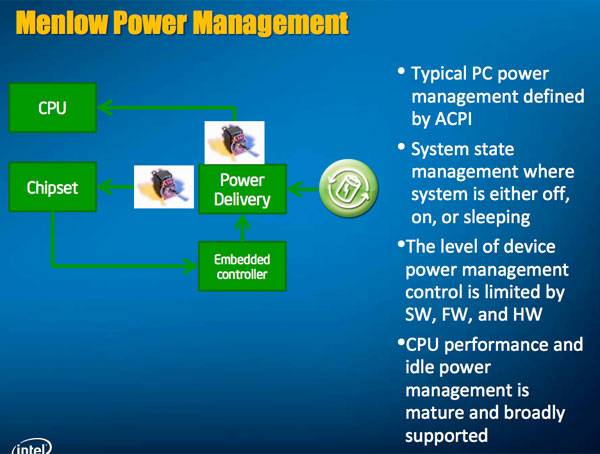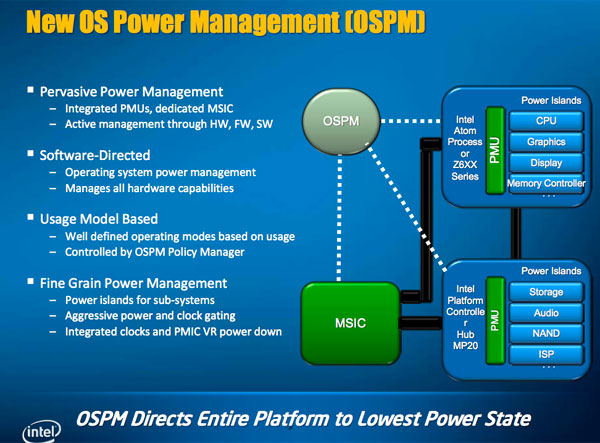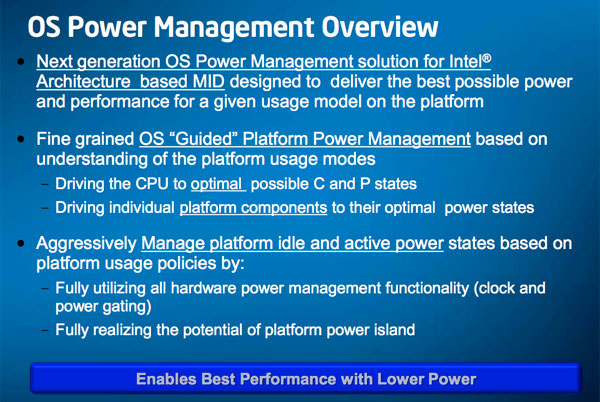Intel Unveils Moorestown and the Atom Z600, The Fastest Smartphone Platform?
by Anand Lal Shimpi on May 4, 2010 11:54 PM EST- Posted in
- Smartphones
- Intel
- Atom
- Mobile
- SoCs
OS Driven Power Management
When Intel introduced Nehalem and the Core i7, we saw a new generation of power engineering in microprocessors. In the past, the OS would request a particular performance state from the CPU and the chip would respond by changing its clock speed. Nehalem’s Power Control Unit (PCU) instead dedicated enough transistors to build a 486 to monitoring the power and performance demands on the chip. Based on those demands and what the OS was doing, the PCU would power up or down individual cores, as well as move clock speeds up or down. The PCU would guess at what the OS was trying to do and respond accordingly.
Nehalem and its successors were massive chips, eating up to 130W of power under load and idling down in the 6 - 10W range. Lincroft has to be sub-1W under load and 6mW at idle. With even more stringent power demands and a much smaller die, Intel couldn’t blow a sizeable percentage of the Lincroft transistor budget on power management.

Instead of guessing at what the OS wants, the Moorestown platform uses OS Driven Power Management (OSPM) to tell Lincroft and Langwell what to do. OSPM is supported in Moblin and presumably the Wind River build of Android.

The OSPM process tells the hardware what apps it’s running and to shut down what it doesn’t need. There are well defined operating modes - standby, internet browsing, MP3 playback, video playback, voice call, video capture, etc... Based on the profile, the hardware doesn’t have to guess at what it should turn off/on, it just does it right away.
The OSPM driver communicates directly with the two power management units in Moorestown - one in Lincroft and one in Langwell. It instructs those PMUs to shut off various blocks, and in turn they tell Briertown to gate and cut voltage to the parts of chip that aren’t needed.

I wondered if this couldn’t be done in hardware, but it seems that given current die constraints and the sort of accuracy of information it needs Intel must implement at least some of the power management control in software. Toolkits will be available for developers to control the OSPM.










67 Comments
View All Comments
strikeback03 - Wednesday, May 5, 2010 - link
No, I think he is asking for Windows 7, not Windows Phone 7. WHich I can see being useful on a tablet, but not at all on a phone. It would take so much effort to turn the standard version of Windows 7 into something usable on a phone that I would imagine if x86 does take off in smartphones Microsoft would be better off just making a completely new OS that can run windows programs.logdrum - Saturday, November 20, 2010 - link
There are Moorsetown tablets running Windows 7, As long as the chipset has a PCI bus Windows 7 heck even Windows 2003 server shuld install. The smart phone do not have a PCI bus therefore you cannot install Windows 7logdrum - Saturday, November 20, 2010 - link
It is not a limitation of x86. Windows needs a PCI bus to install and run. There is no PCI bus in Intel embedded systems or ARM for that matter. Having said that you can install VMware on the Linux OS and install Windows as a Virtual Machine. Some people even say hacking the firmware of the embedded hardware to fake a PCI bus so Windows would install. It could be done. Take one of those WindRiver classes on fastboot and kboot and maybe you could make it happen.logdrum - Saturday, November 20, 2010 - link
I am talking here purely x86 Windows, the one on desktops and netbooks and even tablets. Tablets have a PCI bus usually. The phone factor of Moorsetown does not have,jaydee - Wednesday, May 5, 2010 - link
Dual-boot Windows 7 and Android on a 10" tablet. Please?arnavvdesai - Wednesday, May 5, 2010 - link
I think getting 3 out of 5 will be very hard for Intel, especially Apple because that company has sunk so much of its own money into chip IP. Apple is not content with just getting the best hardware out there in ARM world but wants to actually design the chip around its own OS so I dont see them using the Atom series.Intel says Win7CE & Win8CE are both out so that leaves them in a bad place. However, Microsoft is working on a micro OS kernel inside its labs called Menlo( I am not sure about the name) which Intel could try and effectively market to. Basically in Menlo Microsoft is trying to shrink NT to super small size and footrpint.
DanNeely - Wednesday, May 5, 2010 - link
Intel offered the ability to create custom atom SOC's via TSMC fabs about a year ago. It was withdrawn due to lack of interest; but if apple was interested I'm certain they'd make it available again.aguilpa1 - Wednesday, May 5, 2010 - link
People will forgive lots of things if the thing just looks HOT and works as it should. It has been a long time since I have been wowed by any of the new smartphone devices, including the iphone. It is sleek and well built but a little to chunky and roundish for my taste. However they get the style look down.geniekid - Wednesday, May 5, 2010 - link
Would it be possible to leverage Moorestown in a way that yields 2x the battery life with the same performance as today's top end smartphones? Most 3GS/N1 users today would rather have more battery life than HD playback ability. Unfortunately, as I think about it, I believe that the battery sucking features of the phone are the peripheral devices - wifi/3g radio, camera, display, things which are outside the scope of Moorestown.Mike1111 - Wednesday, May 5, 2010 - link
If the Z600 only support 1024x600 or higher, how come the Aava reference platform has 800x480?And even though I think the performance is very good, Z600 is still too big to compete in the Smartphone market (3-4 chips instead of 1)? I don't see how that could work with something as small as the iPhone 4th-gen's mainboard, which is incredible tiny.
Also Intel talks about combining Lincroft and Langwell into one chip, but no official word on memory in the same package? Only Anand speculates about it.
But if they Intel can integrate at least these three chips into one package with Medfield and offer some additional improvements plus @32nm, and have actual Medfield smartphones on the shelves by the holiday season 2011, Intel can finally start to compete in the smartphone market.